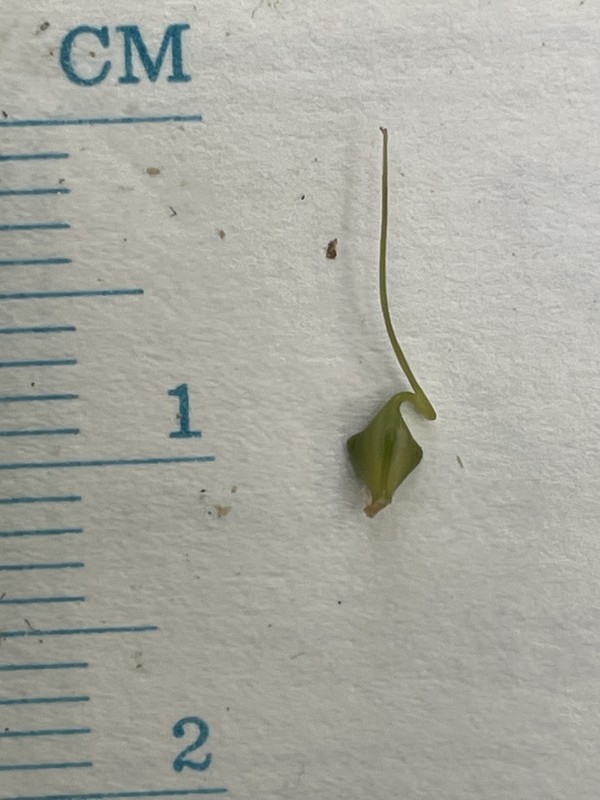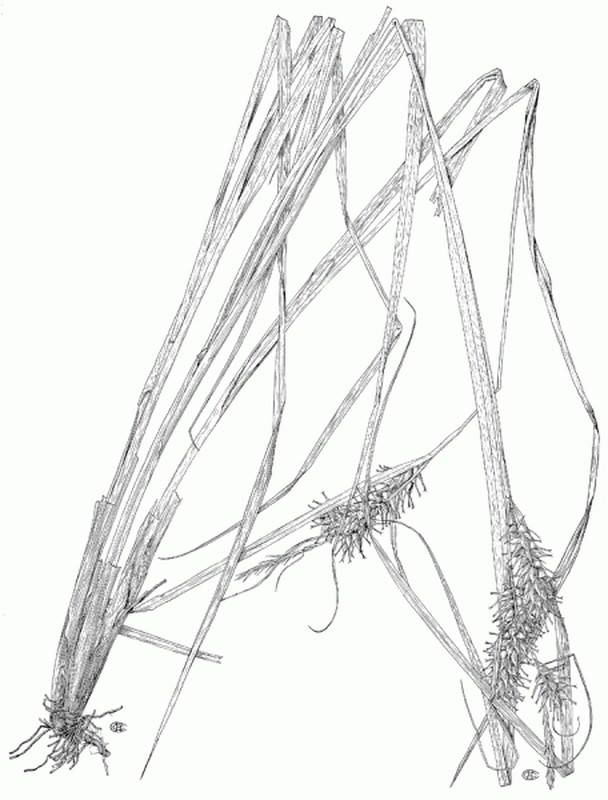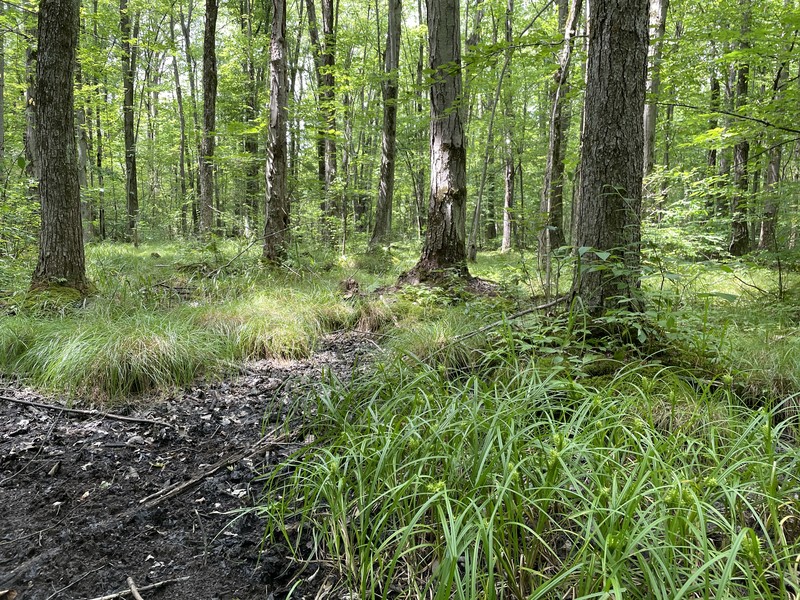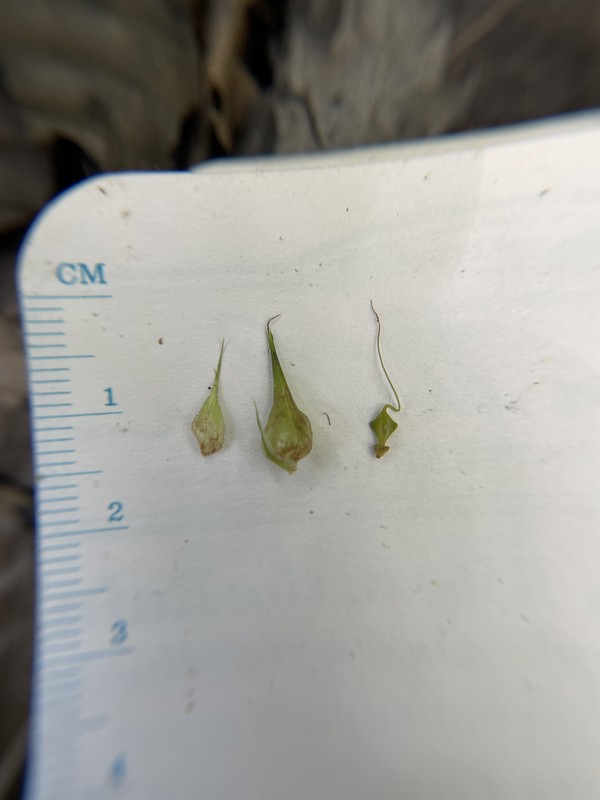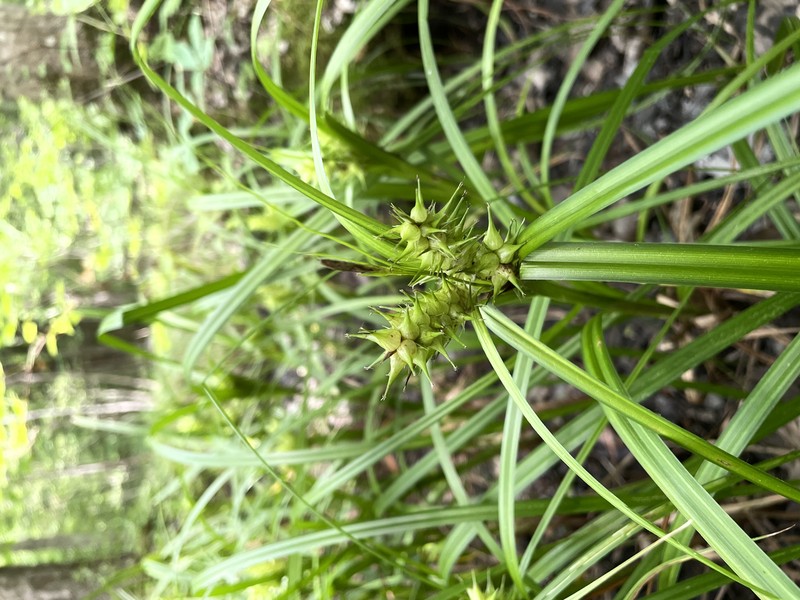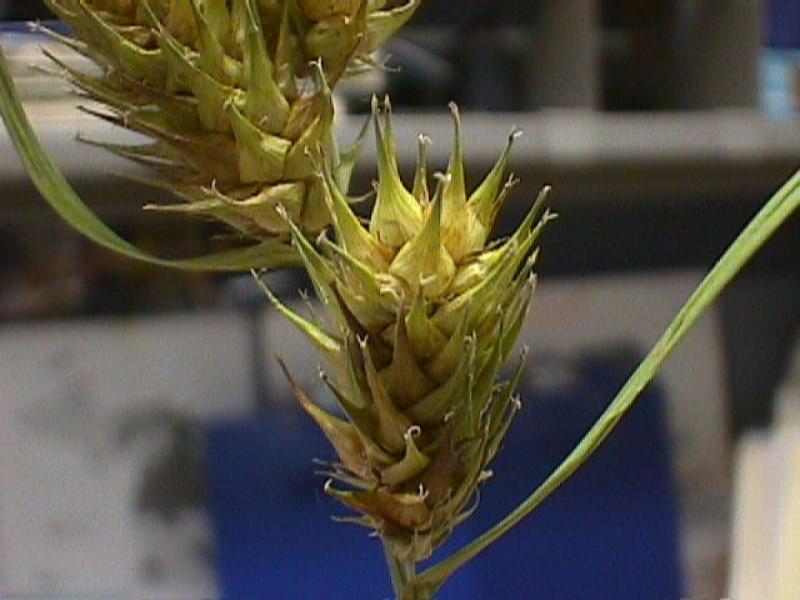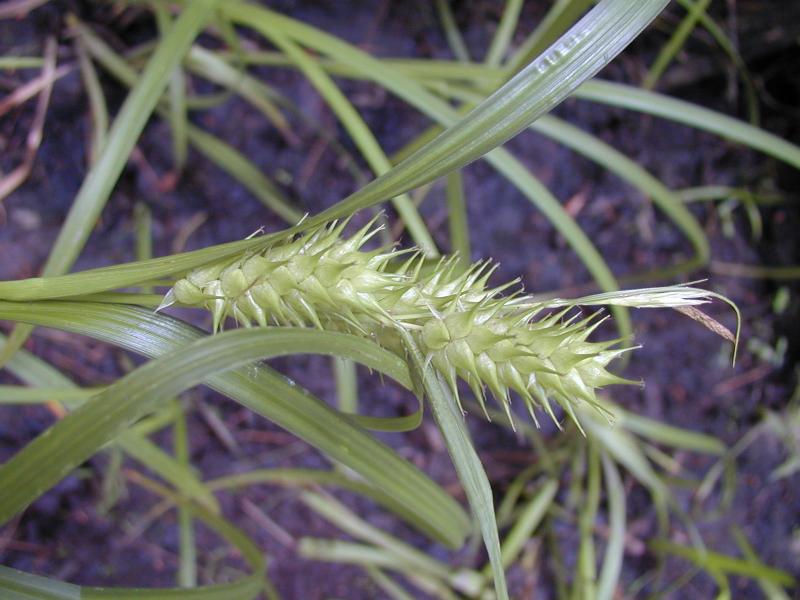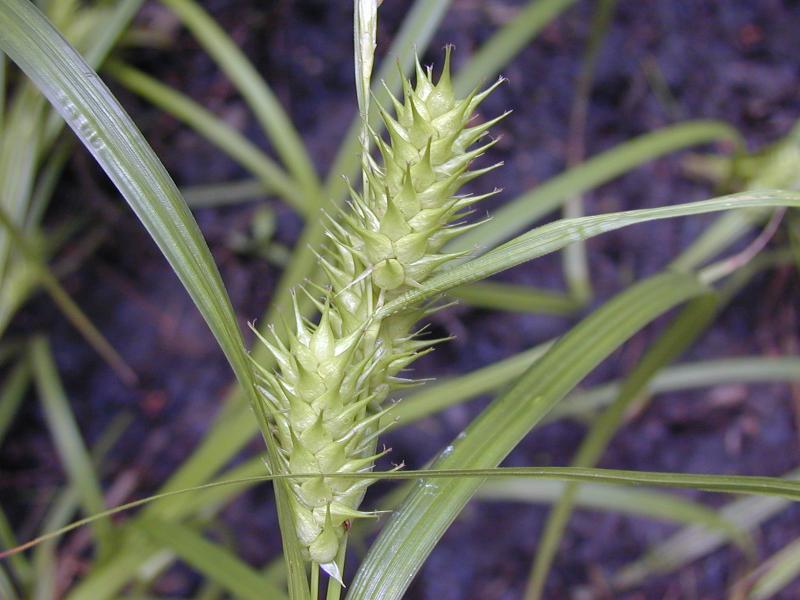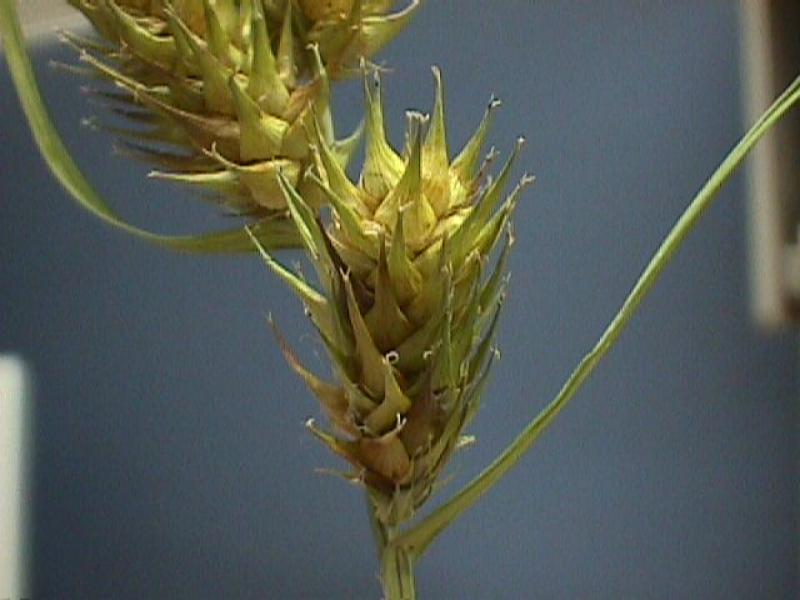False Hop Sedge
Carex lupuliformis Sartwell ex Dewey
- Class
- Monocotyledoneae (Monocots)
- Family
- Cyperaceae (Sedge Family)
- State Protection
- Threatened
Listed as Threatened by New York State: likely to become Endangered in the foreseeable future. For animals, taking, importation, transportation, or possession is prohibited, except under license or permit. For plants, removal or damage without the consent of the landowner is prohibited.
- Federal Protection
- Not Listed
- State Conservation Status Rank
- S2
Imperiled in New York - Very vulnerable to disappearing from New York due to rarity or other factors; typically 6 to 20 populations or locations in New York, very few individuals, very restricted range, few remaining acres (or miles of stream), and/or steep declines.
- Global Conservation Status Rank
- G4
Apparently Secure globally - Uncommon in the world but not rare; usually widespread, but may be rare in some parts of its range; possibly some cause for long-term concern due to declines or other factors.
Summary
Did you know?
This sedge can be searched for very late in the season as it tends to stay green into October and even early November. The spikelets are host to a fly parasite which may result in deformed fruits. The specific name is derived from the resemblance of its inflated fruits to hops (Humulus lupulus).
State Ranking Justification
There are 16 reported populations, but only seven of these have more than 25 plants. There are about 20 historical populations and these should be surveyed to determine if the plants are still present. Difficulty with keys/characters have led to misidentifications and the late ripening of fruit has likely limited the number of successful surveys for this plant. This plant has likely always been uncommon within New York as it has a limited distribution, specific habitat, and typically has small populations.
Short-term Trends
There have not been enough follow-up surveys to determine trends.
Long-term Trends
There have probably always been less than 50 populations in the state and there may have been some declines from loss of habitat but it is difficult to tell because of past misidentification of the species.
Conservation and Management
Threats
There are no immediate threats known for this species.
Conservation Strategies and Management Practices
No management needs are known at this time.
Research Needs
More research needs to be done into the best time of year to survey this plant in New York. Based on current data, we believe surveys should be conducted late summer and through the fall. All of the herbaria vouchers identified to either Carex lupuliformis or Carex lupulina should be verified to determine if they are indeed these species. Initial work has found that many specimens identified as Carex lupuliformis are actually large, healthy examples of Carex lupulina.
Habitat
Habitat
A sedge of silver maple-ash swamps, red maple hardwood swamps, floodplain forests, marshes, shrub swamps, and mucky soils. Often associated with limy clay or other types of calcareous soils (New York Natural Heritage Program 2004). Wet forests, especially in openings around forest ponds, riverine wetlands, marshes, wet thickets (Flora of North America 2002). In open marshes or along shores, sometimes in shallow water, or in very wet floodplain forests (Gleason & Cronquist 1991). Calcareous swamps, meadows and prairies (Fernald 1970).
Associated Ecological Communities
- Deep emergent marsh*
(guide)
A marsh community flooded by waters that are not subject to violent wave action. Water depths can range from 6 in to 6.6 ft (15 cm to 2 m). Water levels may fluctuate seasonally, but the substrate is rarely dry, and there is usually standing water in the fall.
- Floodplain forest
(guide)
A hardwood forest that occurs on mineral soils on low terraces of river floodplains and river deltas. These sites are characterized by their flood regime; low areas are annually flooded in spring, and high areas are flooded irregularly.
- Inland calcareous lake shore*
(guide)
The gravelly, sandy, or muddy shore of an inland lake or pond with calcareous water and seasonally fluctuating water levels. There may be few plants and those that are present are usually herbaceous.
- Red maple-hardwood swamp
(guide)
A hardwood swamp that occurs in poorly drained depressions, usually on inorganic soils. Red maple is usually the most abundant canopy tree, but it can also be codominant with white, green, or black ash; white or slippery elm; yellow birch; and swamp white oak.
- Sedge meadow*
(guide)
A wet meadow community that has organic soils (muck or fibrous peat). Soils are permanently saturated and seasonally flooded. The dominant herbs must be members of the sedge family, typically of the genus Carex.
- Shallow emergent marsh
(guide)
A marsh meadow community that occurs on soils that are permanently saturated and seasonally flooded. This marsh is better drained than a deep emergent marsh; water depths may range from 6 in to 3.3 ft (15 cm to 1 m) during flood stages, but the water level usually drops by mid to late summer and the soil is exposed during an average year.
- Shrub swamp*
(guide)
An inland wetland dominated by tall shrubs that occurs along the shore of a lake or river, in a wet depression or valley not associated with lakes, or as a transition zone between a marsh, fen, or bog and a swamp or upland community. Shrub swamps are very common and quite variable.
- Silver maple-ash swamp
(guide)
A hardwood basin swamp that typically occurs in poorly-drained depressions or along the borders of large lakes, and less frequently in poorly drained soils along rivers. These sites are characterized by uniformly wet conditions with minimal seasonal fluctuations in water levels. The dominant trees are usually silver maple and green ash.
- Unpaved road/path
A sparsely vegetated road or pathway of gravel, bare soil, or bedrock outcrop. These roads or pathways are maintained by regular trampling or scraping of the land surface. The substrate consists of the soil or parent material at the site which may be modified by the addition of local organic material (woodchips, logs, etc.) or sand and gravel. Abandoned railroad beds where tracks have been removed are included here. One characteristic plant is path rush.
- Vernal pool*
(guide)
An aquatic community of one or more intermittently ponded, small, shallow depressions typically within an upland forest. Vernal pools are typically flooded in spring or after a heavy rainfall, but are usually dry during summer. Substrate is typically dense leaf litter over hydric soils. Vernal pools typically occupy a confined basin (i.e., a standing waterbody without a flowing outlet), but may have an intermittent stream flowing out of it during high water. This community includes a diverse group of invertebrates and amphibians that depend upon temporary pools as breeding habitat. These include amphibians, reptiles, crustaceans, mollusks, annelids, and insects.
* probable association but not confirmed.
Associated Species
- Acer rubrum
- Acer saccharinum (silver maple)
- Apios americana (groundnut)
- Bidens frondosa (devil's beggar-ticks)
- Boehmeria cylindrica (false nettle)
- Calamagrostis canadensis
- Carex comosa (bristly sedge)
- Carex crinita
- Carex grayi (Gray's sedge)
- Carex lupulina (hop sedge)
- Carex tuckermanii (Tuckerman's sedge)
- Cornus amomum
- Eupatorium perfoliatum (boneset)
- Fraxinus pennsylvanica (green ash)
- Glyceria striata (fowl manna grass)
- Leersia virginica (white cut grass)
- Onoclea sensibilis (sensitive fern)
- Symplocarpus foetidus (skunk-cabbage)
Range
New York State Distribution
A bladder sedge with scattered populations throughout the state. Due to confusion with Carex lupulina, this plant may be reported from areas where it really is not present. The wetlands along Lake Champlain possibly possess some of the best populations of this plant in New York.
Global Distribution
A sedge ranging from Vermont and adjacent Quebec, west to Minnesota, south to Virginia, Kentucky, and Texas.
Identification Comments
General Description
This is a large stout sedge with one or a few erect stems up to 1.3 meters tall sticking out above the clump of wide green leaves. There are 1-5 large and fat cylinder-shaped female spikes toward the top of the stem with inflated flower bracts (perigynia). The diamond-shaped fruits have small knobs on the angles that often break through and stick out of the flower bracts late in the season.
Identifying Characteristics
A plant of wet soils, this bladder sedge (section Lupulinae) may have erect stems up to 1.3 meters tall. The key distinguishing feature of this plant is the presence of knobs or "nipple-like points" on the angles of mature achenes. As a useful field key, Carex lupuliformis tends to remain much greener late into the fall season compared to other sedges.
Best Life Stage for Proper Identification
Mature achenes are a must to properly identify this sedge.
Similar Species
More robust specimens of Carex lupulina are frequently confused for Carex lupuliformis. The achenes of Carex lupulina can have concave sides and the sharp angles are often confused for knobs. Comparison of the achenes of true Carex lupuliformis are advisable to determine exactly what is meant by the "achene knobs."
Best Time to See
While this sedge begins to flower in late spring and fruits begin to form by early July, mature fruits often do not form until late summer. These fruits will persist until early winter. The plants remain green until late fall. Since the plants stand out more after frost and have mature achenes at this point, the ideal survey time is late September to mid-November.
- Fruiting
The time of year you would expect to find False Hop Sedge fruiting in New York.
False Hop Sedge Images
Images of Similar Species
Taxonomy
False Hop Sedge
Carex lupuliformis Sartwell ex Dewey
- Kingdom Plantae
- Phylum Anthophyta
- Class Monocotyledoneae
(Monocots)
- Order Cyperales
- Family Cyperaceae (Sedge Family)
- Order Cyperales
- Class Monocotyledoneae
(Monocots)
- Phylum Anthophyta
Additional Common Names
- Sedge
Comments on the Classification
This sedge is a member of the the easily recognized bladder sedge group (section Lupulinae).
Additional Resources
Best Identification Reference
Flora of North America Editorial Committee. 2002. Flora of North America, North of Mexico. Volume 23. Magnoliophyta: Commelinidae (in part): Cyperaceae. Oxford University Press, New York. 608 pp.
Other References
Fernald, M.L. 1950. Gray's manual of botany. 8th edition. D. Van Nostrand, New York. 1632 pp.
Gleason, Henry A. and A. Cronquist. 1991. Manual of Vascular Plants of Northeastern United States and Adjacent Canada. The New York Botanical Garden, Bronx, New York. 910 pp.
Holmgren, Noel. 1998. The Illustrated Companion to Gleason and Cronquist's Manual. Illustrations of the Vascular Plants of Northeastern United States and Adjacent Canada. The New York Botanical Garden, Bronx, New York.
Mitchell, Richard S. and Gordon C. Tucker. 1997. Revised Checklist of New York State Plants. Contributions to a Flora of New York State. Checklist IV. Bulletin No. 490. New York State Museum. Albany, NY. 400 pp.
New York Natural Heritage Program, New York State Department of Enviromental Conservation. March 1998. Element Occurrence Record Database. Latham, NY.
New York Natural Heritage Program. 2024. New York Natural Heritage Program Databases. Albany, NY.
Reschke, Carol. 1990. Ecological communities of New York State. New York Natural Heritage Program, New York State Department of Environmental Conservation. Latham, NY. 96 pp. plus xi.
Weldy, T. and D. Werier. 2010. New York flora atlas. [S.M. Landry, K.N. Campbell, and L.D. Mabe (original application development), Florida Center for Community Design and Research http://www.fccdr.usf.edu/. University of South Florida http://www.usf.edu/]. New York Flora Association http://newyork.plantatlas.usf.edu/, Albany, New York
Links
About This Guide
Information for this guide was last updated on: November 23, 2022
Please cite this page as:
New York Natural Heritage Program. 2024.
Online Conservation Guide for
Carex lupuliformis.
Available from: https://guides.nynhp.org/false-hop-sedge/.
Accessed July 27, 2024.
